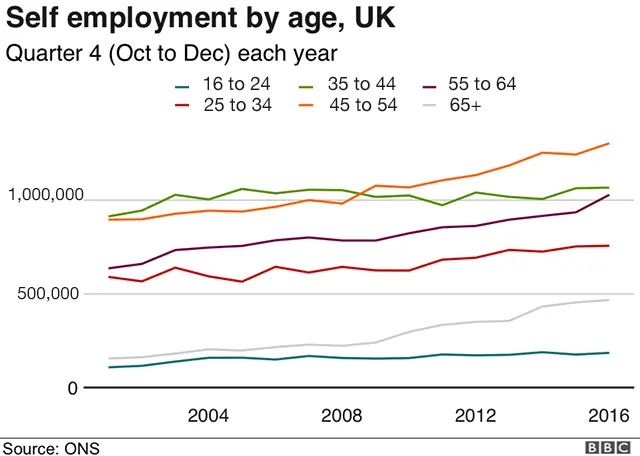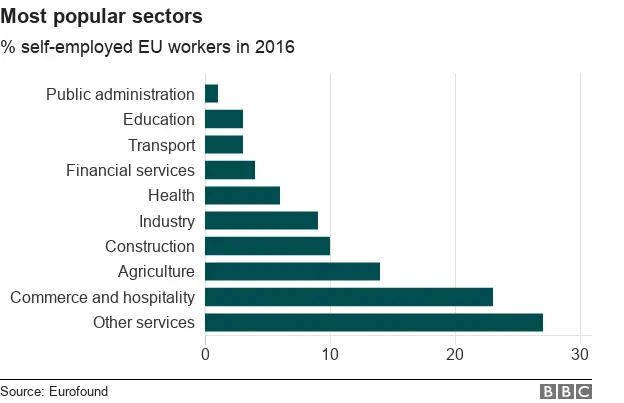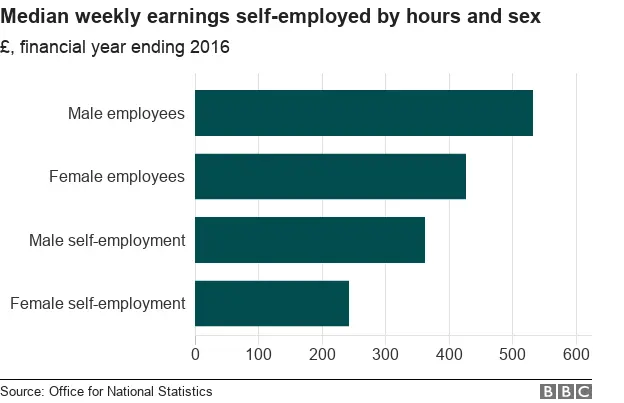Going solo: The rise of self-employment
 Getty Images
Getty ImagesThe number of self-employed workers has been on the up in the UK since 2001 and they now account for around 15% of the working population.
Following the recession, the number of self-employed workers aged 65 and above has nearly tripled.
Young people are also keen to become their own bosses - with the number of self-employed workers aged 16 to 24 nearly doubling since 2001.
So BBC News asks, why is self-employment more popular with the young and old, and what protection do workers have?
1. A job for life?
In the UK, self-employment has risen rapidly over the last two decades.
The number of self-employed workers has increased from 3.3 million in 2001 to 4.8 million in 2017, according to the Office for National Statistics (ONS).
Somebody could be classified as self-employed if they
- own a business, rather than working for an employer
- agree a fixed price for their work with their employer or client
- decide on their own schedule when work is available
- can work for more than one client
- provide the tools, equipment or materials that are needed to complete a job
Self-employment can take many forms - including entrepreneurs and freelancers, gig economy workers or contractors.
This doesn't include zero-hours workers, who have the same employment rights as regular employees.
 BBC News
BBC NewsThe largest number of self-employed workers overall are aged 45 to 54.
But the most rapid increase has occurred in self-starters aged 65 and above, where numbers have grown from 159,000 to 469,000 between 2001 and 2016.
A total of 181,000 16 to 24-year-olds were classified as self-employed workers in 2016 - up 74% from the 104,000 in 2001. This makes young people the second fastest-growing group of self-employed workers, with part-time work accounting for most of the rise.
The unemployment rate in the UK fell to 4.2% in the three months to May 2018, the joint lowest since 1975. The rise in self-employment helped boost jobs growth overall following the recession, according to the ONS.
Think tanks like the Resolution Foundation have questioned whether the overall rise comes from a desire for flexible working, or whether some workers had no other choice.
2. Most popular careers
Across the European Union, there were 33 million people in self-employment in 2016, and 188 million employees.
Shopkeeping, hairdressing and domestic cleaning are the most popular professions among self-employed workers with no employees of their own, according to a study by Eurofound, the EU agency which monitors labour markets.
Service sectors account for the largest share of the self-employed labour force.
 BBC News
BBC NewsIt's also thought that self-employment has flourished with the rise of technology. Wi-fi, cloud sharing services and video calls mean that people can work from anywhere and at any time.
Jordan Marshall, policy development manager at the Association of Independent Professionals and the Self Employed, said: "Being self-employed allows young people, in particular, to work on the projects they are truly passionate about, when and where they want.
"Technology has made this all so much easier, whether finding work through online platforms or even being a 'digital nomad' - travelling the world while doing remote freelance work.
"But, self-employment isn't without its challenges, whether that's getting a firm grip on your finances or finding work in an industry where you may not have many contacts."
3. Who earns more?
In 2016, men, whether full-time employees or self-employed workers, earned more than women in the UK, according to data from the ONS.
Median weekly earnings (the middle value when everyone's wages are arranged from highest to lowest) for self-employed men stood at £363 per week, compared with £243 for their female counterparts.
 BBC News
BBC NewsAcademics at the University of Sheffield have said that as more women move into paid work, mothers in particular favour flexibility in their working hours.
But, it seems they aren't as well-compensated.
Female entrepreneurs working part-time were the worst off - earning £120 per week in 2016.
4. What protections are there?
Self-employed workers running their own business take responsibility for its successes and its failures.
A self-employed worker has protection for their health and safety when working with a client and in some cases will be protected against discrimination.
They will usually have their rights and responsibilities set out in a contract with their client.
Last year, the Taylor Review into working practices recommended that the government classify gig economy workers like Uber drivers as dependent contractors, rather than self-employed workers, to help improve their rights.
The government has since promised to overhaul employment rights, and is consulting on proposals around holiday and sick pay rights.
